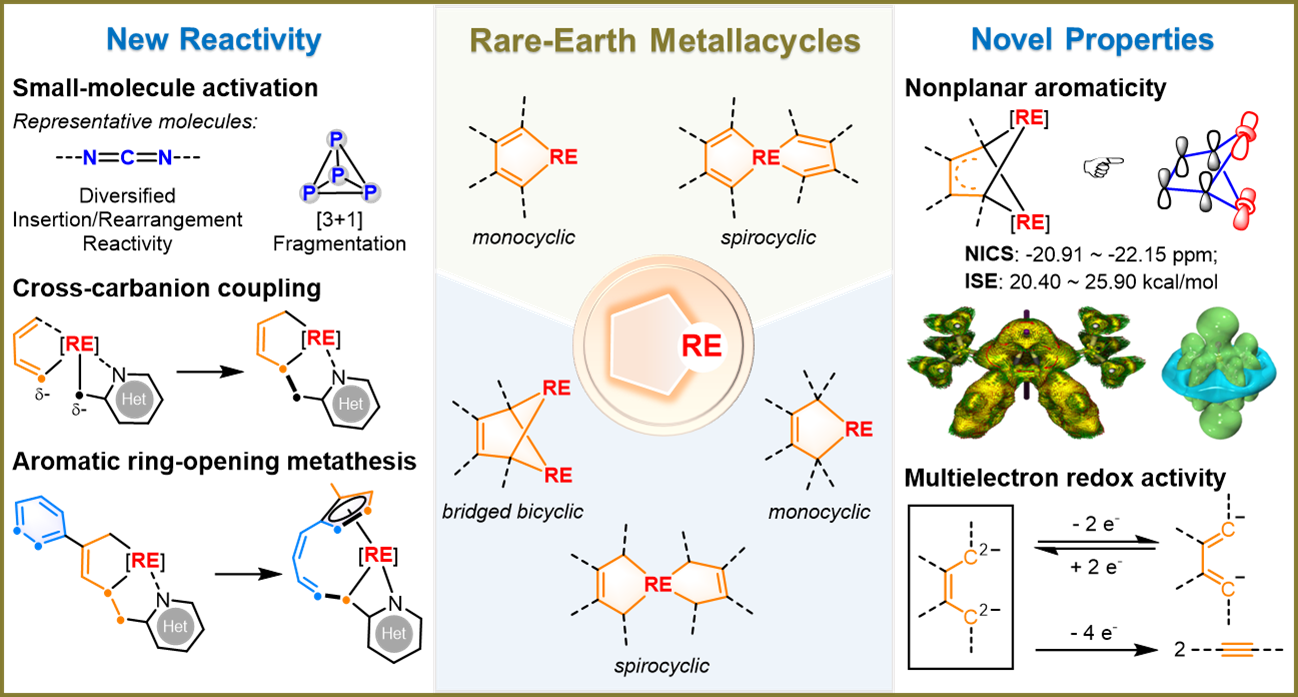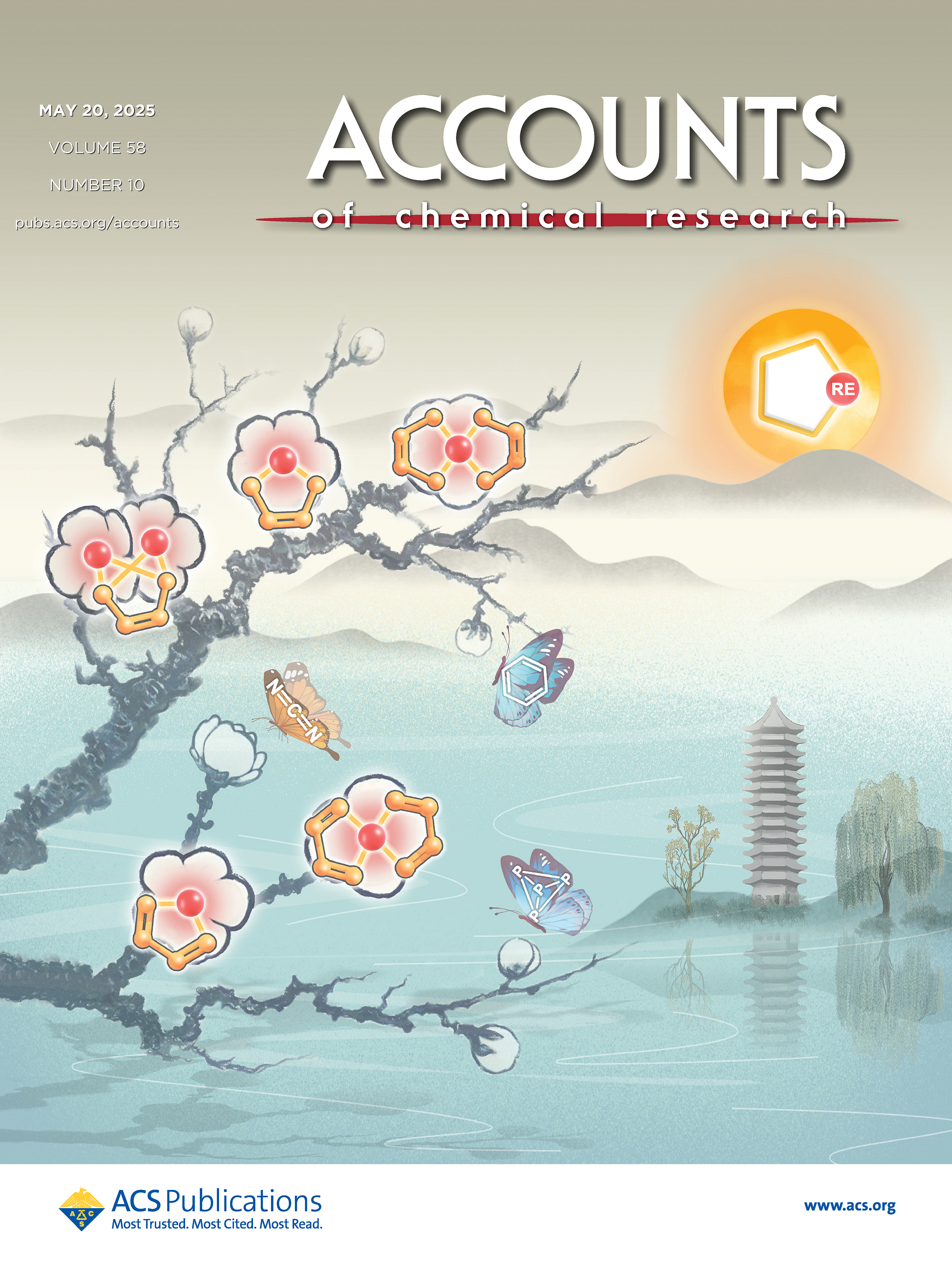Enchanting Realm of Five-Membered Rare-Earth Metallacycles
Wei Liu, Dajiang Huang, Junnian Wei, and Wen-Xiong Zhang*
Acc. Chem. Res. 2025, 58, 1696–1709.
https://doi.org/10.1021/acs.accounts.5c00168


Metallacycles, derivatives of carbocyclic compounds wherein a metal replaces at least one carbon center, have been a constant powerhouse in organic synthesis. While metallacycles of main group, transition, and actinide metals have been extensively studied, those incorporating rare-earth (RE) elements (Sc, Y, and lanthanides) have remained elusive primarily due to synthetic challenges. Nevertheless, the electropositive character of these elements and the resulting polarization of RE-C bonds, along with the intrinsic synergistic effects within metallacycles, endow rare-earth metallacycles with unique properties and a rich, yet largely untapped, reaction chemistry. In this Account, we present the development and applications of five-membered rare-earth metallacycles.
Over the past decade, we have successfully synthesized a variety of five-membered all-carbon rare-earth metallacycles using two key synthetic strategies: (i) transmetalation, which has been employed to prepare rare-earth metallacyclopentadienes and spiro-metallacyclopentadienes, which, featuring various ligand systems, provide distinct coordination environments around the rare-earth center, significantly influencing their reactivity; and (ii) transmetalation-and-reduction, enabling the synthesis of rare-earth spiro-metallacyclopentenes and 2-butene tetraanion (BTA) bridged dinuclear rare-earth metallacyclopentenes. The reduction process proceeds via either self-disproportionation of metallacyclopentadienes or reduction by divalent rare-earth centers or alkali metals. These metallacycles represent the first instances of such rare-earth-containing metallacyclic ring structures.
Our investigations into these metallacycles have uncovered unique reactivities and new reaction modes. The high intrinsic reactivity and multiple reactive sites of rare-earth metallacycles enable them not only to activate small molecules efficiently but also to exhibit distinct activation modes for some small molecules. For instance, reactions of rare-earth metallacyclopentadienes with carbodiimides showcase diverse insertion/rearrangement chemistry, influenced by various factors such as carbodiimide equivalents and solvent choice. The rare-earth metallacyclopentadiene-mediated [3+1] fragmentation of white phosphorus demonstrates an activation mode markedly different from that observed with main group and transition metal analogs. Moreover, the discovery of cross-carbanion coupling at rare-earth centers and rare-earth metal-mediated ring-opening metathesis of benzene introduces new reaction modes, demonstrating that, with rational design, rare-earth metals can exhibit properties similar to or even surpassing those of transition metals. These reaction modes have further led to the development of applications for rare-earth metallacycles in synthetic chemistry.
Additionally, some novel properties of these rare-earth metallacycles have been uncovered, stemming from their unique geometric and electronic structures. Structural analysis and theoretical calculations have revealed the nonplanar aromaticity of BTA-bridged dinuclear rare-earth metallacyclopentenes, extending the concept of nonplanar aromaticity into the chemistry of carbon-rare-earth metals. Furthermore, benefiting from the redox capabilities of butadiene dianion and BTA ligands, the ligand-based redox chemistry of BTA-bridged dinuclear rare-earth metallacyclopentenes demonstrates diverse and efficient multielectron transfer processes, highlighting the potential of these metallacycles for redox chemistry.
The studies of rare-earth metallacycles, encompassing their construction, characterization, properties, reactivity, and synthetic applications, have greatly enriched the field of f-block metallacycles. We hope this Account will inspire further exploration into the synthesis of new organometallic reagents and metallacycle-mediated transformations, fueling continued progress in rare-earth chemistry.




